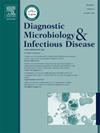Molecular study of candiduria in pediatric patients in in relation to biofilm formation and fluconazole tolerance
IF 2.1
4区 医学
Q3 INFECTIOUS DISEASES
Diagnostic microbiology and infectious disease
Pub Date : 2025-06-07
DOI:10.1016/j.diagmicrobio.2025.116943
引用次数: 0
Abstract
Background
There are limited studies about the presence of Candida species (Candida spp.) and ABC genotypes in hospital acquired urinary tract infection (UTI) in children.
Aim
the study aimed at identification of Candida spp. associated with candiduria in children, detection of fluconazole tolerance and biofilm formation and genotyping of C. albicans.
Method
The study was conducted on pediatric patients with hospital-acquired UTI. A urine sample was cultured on the agar CHROM Candida. Molecular identification of Candida spp. was performed by nested polymerase chain reaction (PCR) and specific genotyping of C. albicans was performed by PCR. Biofilm production and fluconazole tolerance were tested for the isolates.
Results
97 children were included. Urinary catheters were inserted reported in 69.1 % of the children and previous antibiotic intake was reported in 34 % of them. The identified species were C. albicans (66 %) followed by Nakaseomyces glabrata (19.6 %), Candida tropicalis (11.3 %) and Candida kruzei (3.1 %). The ability of biofilm formation was 100 %. The Pichia kudriavzevii had a highest significant rate of fluconazole tolerance (66.7%), (P=0.045). Resistance to fluconazole was observed significantly with C. tropicalis (63.6%), (P=0.033). The common genotypes of C. albicans were A (60.9%) and C (39.1%). There was significant capacity of C. albicans genotype C to form strong biofilm (P<0.001).
Conclusion
The study found that C. albicans remains the most prevalent species in candiduria. The ability of Candida spp. to form biofilms was 100% among the isolates. Strong biofilm formation being significantly associated with increased fluconazole resistance and C. albicans genotype C.
儿童患者念珠菌与生物膜形成和氟康唑耐受性的分子研究
背景关于念珠菌种类(念珠菌属)和ABC基因型在儿童医院获得性尿路感染(UTI)中的存在的研究有限。本研究旨在鉴定儿童念珠菌相关念珠菌,检测白念珠菌的氟康唑耐受性和生物膜形成情况,并进行基因分型。方法以医院获得性尿路感染患儿为研究对象。尿液样本在琼脂CHROM念珠菌上培养。采用巢式聚合酶链反应(巢式PCR)对念珠菌进行分子鉴定,对白色念珠菌进行特异性基因分型。对分离菌株进行了生物膜生成和氟康唑耐受性试验。结果纳入97例患儿。据报道,69.1%的儿童插入了导尿管,其中34%的儿童曾服用过抗生素。鉴定的菌种以白色念珠菌(66%)次之,其次为光秃中丝酵母菌(19.6%)、热带念珠菌(11.3%)和克鲁泽念珠菌(3.1%)。生物膜的形成率为100%。毕赤酵母对氟康唑的耐受性最高(66.7%)(P=0.045)。热带恙螨对氟康唑的耐药率为63.6% (P=0.033);白色念珠菌常见基因型为A型(60.9%)和C型(39.1%)。基因型C的白色念珠菌形成强生物膜的能力显著(P<0.001)。结论研究发现白色念珠菌仍是念珠菌中最常见的菌种。念珠菌在分离株中形成生物膜的能力为100%。强生物膜形成与氟康唑耐药性和白色念珠菌基因型增加显著相关。
本文章由计算机程序翻译,如有差异,请以英文原文为准。
求助全文
约1分钟内获得全文
求助全文
来源期刊
CiteScore
5.30
自引率
3.40%
发文量
149
审稿时长
56 days
期刊介绍:
Diagnostic Microbiology and Infectious Disease keeps you informed of the latest developments in clinical microbiology and the diagnosis and treatment of infectious diseases. Packed with rigorously peer-reviewed articles and studies in bacteriology, immunology, immunoserology, infectious diseases, mycology, parasitology, and virology, the journal examines new procedures, unusual cases, controversial issues, and important new literature. Diagnostic Microbiology and Infectious Disease distinguished independent editorial board, consisting of experts from many medical specialties, ensures you extensive and authoritative coverage.

 求助内容:
求助内容: 应助结果提醒方式:
应助结果提醒方式:


